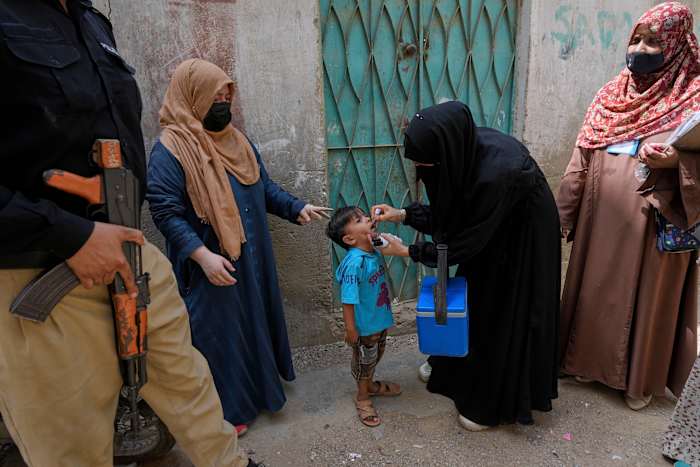KARACHI – A Long-Standing Global Challenge
For nearly 40 years, the World Health Organization (WHO) and its partners have been engaged in a global campaign to eliminate polio, a paralytic disease known to humanity since prehistoric times. Although the number of polio cases has decreased by more than 99%, the disease remains persistent in regions of Afghanistan and Pakistan.
According to workers, experts, and internal documents acquired by the Associated Press (AP), mismanagement and a rigid adherence to obsolete strategies continue to hinder the Global Polio Eradication Initiative. A flawed oral vaccine and bottlenecks in local operations have exacerbated the problem.
Mixed Results in Vaccination Efforts
While officials celebrate milestones such as three billion children vaccinated and an estimated 20 million cases of paralysis avoided, they also acknowledge ongoing challenges in Afghanistan and Pakistan. Dr. Jamal Ahmed, WHO’s polio director, defended achievements in these countries, highlighting targeted responses from workers in resistant areas.
Internal Issues with Vaccination Teams
- Internal WHO reports reveal significant problems within polio vaccination teams in these countries.
- Documents shared with AP indicate that, as early as 2017, local workers reported issues including falsified vaccination records and untrained personnel administering vaccines.
- There were numerous instances where workers failed to manage vaccine storage correctly, leading to concerns over the effectiveness of the immunization efforts.
- A 2017 report from Kandahar pointed out that vaccination teams lacked monitoring plans and only achieved partial coverage in some areas.
Challenges in Community Acceptance
Health officials in the region have emphasized that cultural barriers, vaccine misinformation, and poverty frequently obstruct their vaccination efforts. Sughra Ayaz, who has been actively campaigning in southeastern Pakistan for a decade, has faced resistance from families demanding basic necessities rather than vaccines. Some families, fueled by unfounded rumors, believe that the oral vaccine could sterilize their children.
Ayaz noted the pressure to show positive results has led some managers to instruct workers to falsely report immunizations. “In many places, our work is not done with honesty,” she stated.
The Oral Vaccine Under Scrutiny
Eradicating polio requires flawless execution—eliminating all cases and vaccinating over 95% of children. Yet, some scientists and former WHO officials argue that the strategy is flawed, particularly criticizing the oral vaccine. While it is generally safe and effective, there are rare instances where the live virus in the vaccine can cause paralysis. It can also mutate and spark new outbreaks in areas with low vaccination rates.
Since 2021, several hundred vaccine-linked cases have been reported annually, with at least 98 in just this year. Public health experts widely agree that the oral vaccine should be phased out, though they recognize that an injectable alternative, which carries no live virus and hence fewer risks, is not yet available in sufficient quantities.
Calls for a Strategic Revision
Over two dozen current and former senior officials involved in polio prevention have described a reluctance among agencies to revise their strategies despite existing challenges. Last year, former WHO scientist Dr. T. Jacob John urged WHO Director-General Tedros Adhanom Ghebreyesus via email for a “major course correction,” citing an inconsistency in WHO’s approach that created polio while simultaneously attempting to control it.
Lack of Accountability in the Campaign
Dr. Tom Frieden, a member of an independent board assessing polio eradication efforts, expressed frustration over the lack of actionable management. With an annual budget nearing $1 billion, polio eradication is one of public health’s costliest initiatives, and sustaining funding may prove challenging without tangible progress.
Roland Sutter, a former head of polio research at WHO, highlighted that more than $1 billion has been spent in Pakistan alone over the last five years with minimal results. “If this was a private company, we would demand results,” he remarked. But Ahmed defended the campaign’s successes, stating, “Let’s not overdramatize the challenges, because that leads to children getting paralyzed.”
Ongoing Mistrust of Vaccines
Vaccine workers and health officials recognize the difficulty campaign leadership has in comprehending on-the-ground challenges. Misinformation about the vaccine persists, with tales suggesting that the vaccine contains pig urine or accelerates puberty. Some attribute growing anti-vaccine sentiments in donor countries to eroding trust in vaccination campaigns.
In a rural area of southeastern Afghanistan, a mother expressed her desire to vaccinate her children but noted that familial pressure leads them to reject it, fearing it would harm their fertility. “If I allow it,” she indicated, “I will be beaten and thrown out.”
_____
Cheng reported from London. The Associated Press Health and Science Department is supported by the Howard Hughes Medical Institute’s Department of Science Education and the Robert Wood Johnson Foundation. The AP is solely responsible for all content.







